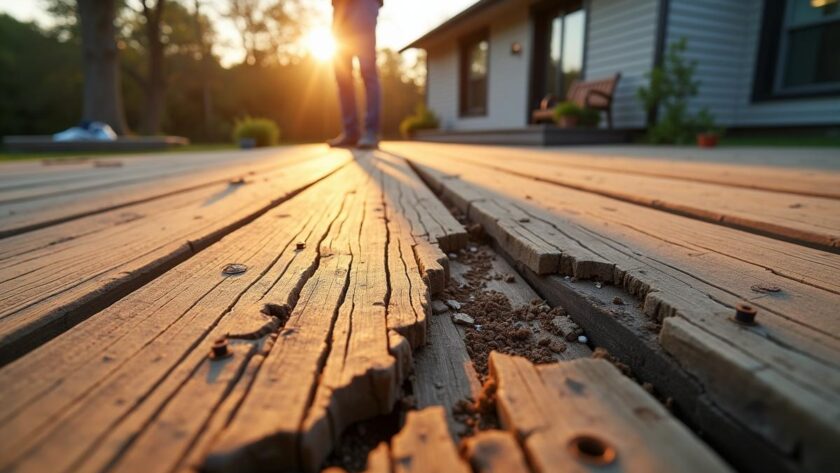When your boards start to crack, you might consider repairing or replacing your old deck. A deck can be your favorite spot for weekend gatherings, so it’s natural to feel a pang of worry when it looks worse for wear. Yet, deciding whether to keep patching it up or invest in an entirely new structure involves more than just appearance. It’s about weighing longevity, budget planning, and how the deck fits into your broader home improvement goals.
Contents
Why Home Repair Matters for an Aging Deck
An older deck can sometimes be saved through meticulous home repair strategies, especially if the damage is confined to a few boards. Checking for rotting wood, loose nails, and warped planks is a vital part of regular maintenance. When you spot these red flags early, you have time to gather a repair estimate before the issues spiral out of control. If you wait too long, hidden structural problems may surface, making your final bill curiously similar to a complete replacement cost.
Looking at any fix or replace question means performing a careful damage assessment. If only a small section shows wear, a quick patch job might be enough. But when the support beams or joists show component failure, you’ll have to think about a system overhaul. This is a good moment to consider your deck’s lifetime value sometimes focusing on smaller repair services prolongs the deck’s life cycle, yet a full rebuild can offer superior quality assurance.
Early Signs You Need a Fix or Replace
Visible splinters, sinkage around the footings, and rust on metal supports typically point to deeper structural flaws. If you tap a board and it feels spongy, that’s often a sign of rot lurking beneath the surface. At times, what appears to be a mere cosmetic blemish might turn into a major performance issue if ignored. Then you’ll find yourself tackling more extensive repairs or even planning a new installation sooner than you’d like.
Evaluating the Cost of Repair vs Replacement
A drive to the hardware store for replacement parts may initially seem cheaper than paying for a new deck, but the final tally could surprise you if you need repeated fixes. Comparing the cost of repair to a potential replacement can help you make an informed choice. Sometimes, calculating your repair vs replace budget is as straightforward as adding up material costs and factoring in labor or technician evaluation fees. If your deck is well within repairable limits, the repair option might be the most economical short-term solution.
However, if your deck’s structure has been compromised, it’s wise to look at the long-term cost comparison. Replacement might offer improved energy efficiency in materials especially if you switch to composite decking that can better withstand the elements, cutting down on future maintenance or part replacement. Although energy efficiency is more frequently discussed in appliance replacement, deck materials also vary in their environmental impact, and cost savings related to upkeep can bolster your budget. In that scenario, a total teardown and new deck might save you from repeated fixes and prolong the structure’s overall life cycle.
A Closer Look at Replacement Cost
While a full rebuild might feel daunting, it can sometimes be less expensive over the life of your home. A new deck leaves you with fresh materials that follow modern efficiency ratings, reducing the likelihood of frequent repairs. With a professional repair service or a reputable contractor, you can explore warranty options that protect you from hidden defects. These warranty coverages typically last longer than any service contract offered for patching up an old structure.
Professional Repair or DIY Repair?
If your time and skills match the scope of the project, DIY repair can be a satisfying adventure in home renovation. Replacing worn boards, driving in new nails, or applying a protective coating can keep common performance issues at bay, provided you know what you’re doing. On the other hand, some fixes like re-leveling your deck’s foundation call for more advanced techniques and specialized tools. Bringing in a professional repair team might speed up the process and guarantee quality assurance.
Professional deck builders and repair services can swiftly identify water damage, structural insecurities, and other red flags. They’ll recommend either minor fixes or a more extensive repair vs upgrade approach. If they see that your support posts are too far gone, they might propose a complete rebuild for peace of mind. Though hiring experts increases the immediate cost of repair, their thoroughness can prevent future headaches. They’re also seasoned at spotting hidden weaknesses, ensuring your deck remains safe and code-compliant.
Warranty Coverage and Service Contracts
Some homeowners underestimate the benefits of warranty coverage on large home improvement projects. If a technician evaluation reveals that your deck needs consistent attention, a service contract may help offset repeated repair expenses. You’ll know upfront if issues like rotting beams or failing fasteners are covered for a certain period. While not as common as appliance maintenance plans, deck service agreements do exist and can shield you from unexpected bills down the road.
Considering Long-Term Solutions Instead of Quick Fixes
As you debate whether to repair or replace, think about how often you’ll be using your deck over the next decade. If you foresee frequent gatherings or a pivot to more outdoor living, you might want to invest in a new deck that can stand up to heavier foot traffic. Sometimes a quick patch-up is only a band-aid solution that puts off the inevitable. In contrast, a sturdy new structure brings enhanced stability and design flexibility, aligning with your long-term solutions for better living space.
Upgrading equipment like deck railings, lighting, and built-in seating might be simpler when you start fresh. While you’re at it, you can consider adding new features that make sense for your lifestyle perhaps a pergola for shade or a built-in firepit. For those looking to sell in the near future, a deck upgrade might even boost property value, a perk that partial fixes can’t always match. Balancing your short-term goals with the deck’s lifetime value helps you see whether an overhaul yields the best return on your money.
DIY Upgrades vs. Professional Overhaul
In some cases, you might try to improve an existing deck by replacing old boards with more durable options. You can opt for composite or high-quality pressure-treated wood to better resist the elements. If you’re comfortable with power tools, a partial swap can solve immediate performance issues. Just be sure you accurately measure the extent of the damage. A thorough troubleshooting session ensures you don’t tear up half the deck only to discover hidden rot in the other half.
Beyond the Deck: A Bigger Home Renovation Perspective
Sometimes, your deck project ties into a broader home renovation plan where you might also tackle appliance replacement or a kitchen remodel. If you’re already planning a renovation, it might be logical to upgrade everything at once for a cohesive look. A brand-new deck can reflect the same modern aesthetic as your indoor spaces, especially if you’re exploring repair vs upgrade options across multiple areas of your residence. By synchronizing your projects, you could save on labor costs and ensure a seamless transition between indoor and outdoor living spaces.
Prioritizing your repairs can also open the door to synergy with other improvements, such as an exterior paint job or landscaping updates. When everything coordinates, you enhance your home’s curb appeal and build a backyard setting that feels like an extension of your interior design. This big-picture approach can simplify budget planning, as you’ll handle cost comparisons and parts replacement across multiple projects at once.
Budgeting for Future Service Needs
Even a freshly built deck might require intermittent maintenance. Staining, sealing, and occasional board replacements keep it in tip-top shape. You can structure the upkeep similarly to appliance maintenance schedules: set calendar reminders for tasks like resealing to maintain the wood’s resilience. Simple, consistent upkeep can prevent more expensive repairs, giving your deck a much longer life cycle cost advantage.
If you’ve chosen advanced materials like composite decking, you might encounter fewer overall repairs, yet the need for a periodic technician evaluation remains. Stay open to minor improvements sometimes a small tweak can fend off larger damage. While life inevitably brings wear and tear, a well-planned service schedule helps avoid big-ticket surprises. If your deck remains well-maintained, you’ll stay off the fix or replace hamster wheel for years to come.
Making the Final Decision
Reviewing all the factors replacement cost, repair estimate, overall home renovation goals, and the enjoyment your deck brings will guide you to the right path. Sometimes, a few new boards and a fresh coat of sealant do the trick, while at other times, rebuilding from scratch is the best call. You’re not just calculating numbers; you’re also prioritizing safety, style, and the lifetime value of your outdoor space.
Whether you end up scheduling professional repair, tackling a DIY project, or drawing up plans for a brand-new deck, keep an eye on warranties and efficiency ratings for the materials you use. Each choice impacts how often you’ll have to address repairs and what your deck can handle in terms of performance. If you align these decisions with your personal preferences, your deck will match both your budget and lifestyle. In the end, whether you repair or replace, the goal is to have a sturdy, inviting space where you can relax and create memories for years to come.




